A salute to trailblazing Denverite
Lt.
Col. John Mosley
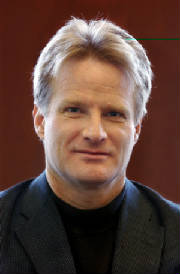
Terry Frei


- PRELUDE: On September 7, 2024, Colorado State University retired
Lt. Col. John Mosley's No. 14 across all sports in a ceremony before the game against Northern Colorado at Canvas Stadium.
Mosley's son, Eric, himself a retired United pilot, and other family members participated in the
ceremony. I long had been advocating renaming a street outside Canvas Stadium to honor Mosley, but this certainly
works. "It was really a special, special weekend, getting to know the Mosley family," CSU coach Jay Norvell said
after the game. "What an amazing family, an amazing group of people that have accomplished so much. I was humbled to
be able to spend time around them."
- Above at left: Eric Mosley acknowledges the cheers
for his father during the ceremony. At right, the family gathers for a photo on the field. CSU President Amy Parsons is at
right.
As I note below, I spoke with and wrote about Mosley many times over the years. This is an omnibus version of my
profile.
John Mosley was a trailblazing
Colorado pioneer on many levels — and in many places.
As a young man in Denver.
As a student, class officer and athlete at what then was Colorado State College of Agriculture
and Mechanic Arts, or Colorado A&M, in Fort Collins.
As a Tuskegee Airman during World
War II, angrily fighting the system.
As a career Air Force man and reservist before finishing
up his working years with the federal government.
And as a co-grand marshal of Denver’s
MLK Day Parade in 2004.
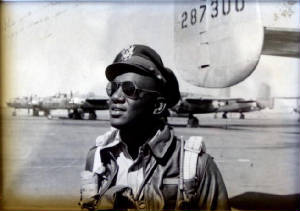
John Mosley at Douglas Army Air Field in Arizona in 1944.
I spoke with him several times for newspaper pieces, for a Fox Sports Rocky
Mountain profile, and also for the "Fourth Down and A War to Go" chapter in my 2010 book, "Playing
Piano in a Brothel." The raw footage DVD of my TV interview with him in his Aurora home ran one hour and 44 minutes.
Because I had interviewed him before, I knew the broad outline of what was coming in our conversation. Yet I nonetheless was
transfixed in places. So was the FSRM crew.
Mosley died at age 93, in 2015.
A lot from our conversations — detailed below — remains striking to me, but none more
than this. I asked him several times how some of his experiences in the time of segregation couldn’t have left him embittered.
We discussed that a lot, and I pulled the interviewer’s trick of asking the same question several
different times … and ways. He could get angry in remembering maddening events, standards and people. But at one point,
when we were talking about his service as a Tuskegee Airman and the Airmen’s role in the eventual desegregation of the
U.S. armed forces by President Harry Truman’s Executive Order in 1948, Mosley circled back.
“You asked why I wasn’t bitter,” he told me. “It was because I was part of the movement to
prove that we were capable of making a contribution to the development of this great nation. We had the foresight to know
that this would be the best nation in the world. And it is the best nation in the world. The Armed Forces would have never
been integrated had it not been for the Tuskegee Airmen proving they could fight, wanted to fight, could be relied on to fight,
and were not afraid of giving their lives to accomplish their missions and goals.”
That’s
getting ahead of the story.

This is a screen shot from the raw footage DVD of my 104-minute on-camera interview with Lt.
Col. John Mosley in the basement of his Aurora home. That's my right shoulder in the foreground. The interview was for a Fox
Sports Rocky Mountain profile that ran in connection with the Rocky Mountain Showdown.
In Denver, he was raised in a home across the street from Whittier School, at roughly 25th and Downing.
(That's between downtown and the current Stapleton.) His father, John Sr., was a porter on the Union Pacific Railroad and
his mother, Henrietta, was a housewife.
“The old expression was that it
takes a village to raise a child,” Mosley told me. “Denver was actually a village at that time, so all the neighbors
and community people in the area helped raise the children. We couldn’t go two or three steps without someone saying
a word of encouragement or criticizing us for what we were doing or not doing.”
Covenants
and standards essentially prevented black families from living anywhere other than extreme northeast Denver. The segregated
lunch counters in downtown Denver included those at Kress and Woolworth. Denver's mayor from 1923-31 and 1935-47 was Ben Stapleton,
at one time a member of the Ku Klux Klan.
As we talked about that, I for the
first time asked him about bitterness.
“I didn’t look at it that way,” Mosley
said. “I looked at it as an opportunity to move ahead. I really didn’t have any bad feelings about who was responsible
for the segregated activities and the types of discrimination we experienced. I was too busy trying to ensure that I got everything
I possibly could out of school and also to participate in athletics.”
Mosley was active
at his church and with the Boy Scouts, and sang in a quartet called the “Junior Mills Brothers.” The quartet appeared
in many of the Denver theaters and also on radio. Sometimes, he told me in wonderment, they each got $5.
He often fished for crawdads at City Park, using pieces of liver as bait, then sold the catches on
Lafayette Street. “Crawdad meat was considered very tasty at the time,” he said.
In a foreshadowing, he visited the National Guard field on what is now Park Hill Golf Course and watched planes
land and take off. “I pretended I was flying,” he said.
He was a National
Merit Scholarship winner and valedictorian, plus an all-city fullback at Denver’s Manual High School. Yet he wasn’t
pursued to play college football, even in the limited recruiting practices of the time. In the fall of 1939, he headed off
to Fort Collins with his childhood buddy, Charles Cousins, also the son of a Pullman porter, and enrolled at Colorado A&M.
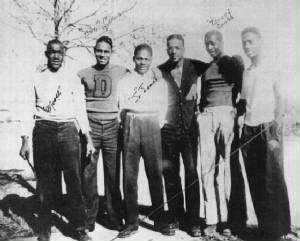
The self-proclaimed “Lonesome
Boys” in Fort Collins. From left to right, John Mosley; Charles Cousins; Jr. James; Howard Kinchelow; Tareet Combs;
and unidentified. (Photo courtesy John Mosley family and John Hirn, athletic historian for Colorado State University.)
At first, Mosley was one of nine African-American A&M students. Six men shared a small house off
campus.
“We called ourselves, ‘The Lonesome Boys,'” Mosley said.
Most of the Fort Collins restaurants wouldn’t serve black people.
“Our whole existence was cooking for ourselves,” Mosley said. “We could eat at the student union
and there was an ice-cream parlor where we could get ice cream. All the rest had signs up. Some of the things were so demeaning,
I didn’t want to recall them, but I do remember.”
He remembered them,
all right. He quoted a couple. They used the “N” word.
Cousins and
Mosley went back and forth from Denver to Fort Collins.
“As a result of working on
the Union Pacific railroad in the summertime, Charles and I were able to acquire Model A Fords,” Mosley said.
These were not new Model A’s.
“We went up in tandem because if one broke down, we were able to have the other pull or shove
or render some help to make sure we made it down from Fort Collins to Denver or back up,” Mosley said.
Housemates nicknamed him “One-Tea Bag Mosley,” because he tried to nurse a single
bag through a month. But they saw no humor in him going out for football as a freshman in 1939, a time when freshmen weren’t
eligible for varsity squads.
“I just showed up and asked for a uniform,”
Mosley said.
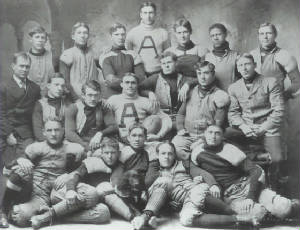
Alfred Johnson is in the
back row, second from right, in the 1905 Colorado Agricultural College team photo.
That
was audacious. World War II had just started in Europe. The U.S. wouldn’t become involved for more than two years.
At the time, there wasn’t a single black player in the Aggies’ Mountain States Conference, which also included
the University of Colorado, University of Denver, Utah, Utah State, Brigham Young and Wyoming.
The CU football program wasn’t integrated until 1954, when Frank Clarke arrived in Boulder, and future NFL
star John Wooten joined him the following year.
Yet in Fort Collins, Harry Hughes,
nearing his 30th anniversary as Colorado A&M’s head coach and athletic director, welcomed Mosley to his program.
“I guess [Hughes] felt that he knew he was retiring soon and to have a black on his football
team was no big deal because they couldn’t do anything to him,” Mosley said.
It
was monumental, but Mosley wasn’t A&M’s first black football player. CSU athletic department historian John
Hirn’s research determined that in the relatively disorganized athletic program in the early 20th century, when the
school was known as Colorado Agricultural College and its teams were in the Colorado Athletic Conference, its football squad
had an African-American player, Alfred Johnson, in 1905 and ’06.
Then segregation
was imposed, whether formally or informally.
Also, by the time Mosley arrived at A&M,
the wrestling program already had been integrated, Hirn notes, with Howard Kinchelow — another of the “Lonesome
Boys” — on the squad in 1937, ’38 and ’39. Kinchelow indeed was the school’s first black athlete
since 1906. Soon, Mosley also went out for wrestling, too, and became a regional champion.
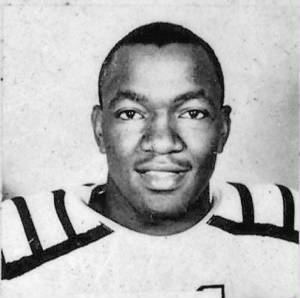
John Mosley played both
fullback and guard for Colorado A&M.
His football teammates’ reactions were mixed, both before
and after he joined the varsity as a sophomore in 1940.
“I had to sell
myself not only to Harry Hughes and the coaches but to the players,” Mosley said. “There were many players from
Texas and the Western slope, farmers and so forth, who didn’t like black people. That was quite an experience to gain
the support of my teammates. My first night out for football, one of the players from the Western Slope tackled me, and in
doing so, he slapped his hands down on my helmet at the ears. That actually knocked me out.
“When I came to, [housemate] Eugene Combs was there on the sidelines watching and he was laughing. He said,
‘I told you not to go out for football. I told you these guys weren’t going to treat you right.’ But the
fact that I could play football and block and tackle was productive in showing what I could offer to the team. I won’t
call out any names now, but there were several players on my team who never accepted me. But most did.”
On the varsity, he was a fullback for two seasons until he was switched to guard as a senior. Some
opponents resented his presence.
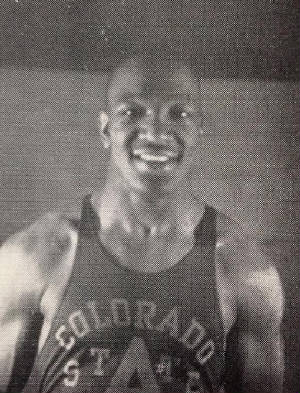
John Mosley as a star wrestler at Colorado A&M
“Naturally,
there was name-calling and that type of thing,” he said. “I had no problem in my responses, because I didn’t
respond. It was my teammates, Dude Dent and Woody Fries, who were quite vocal in ensuring that those voices didn’t get
out too much. The way I responded was through my ability to tackle and to run the ball hard. I never had to ‘fight my
own battles’ on the football field. There were some things that were said, and that was constant, but if anyone tried
to challenge me any other way, all my teammates would come and get in their way.”
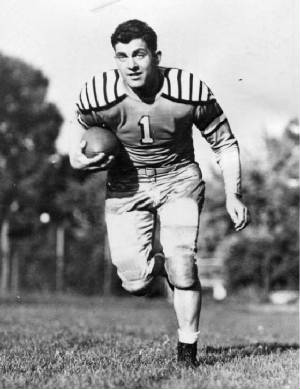
John Mosley’s ally, A&M back Lewis “Dude” Dent.
(Dude Dent, one of his supportive teammates, was from Craig, Colo., and he was
killed in action against German forces in France in August 1944.)
During the 1940 season, when Mosley was a sophomore, the Aggies traveled to Salt Lake City to play Utah. On Friday
night, they went to a movie theater. An usher told Mosley he would have to sit in the balcony.
“As the team went in,” Mosley said, “Coach Hughes asked the players, ‘Hey, where’s
Mosley?’ Somebody said, ‘They sent him upstairs.’ He told the assistant coach, ‘You go in there and
make this announcement: All Aggies, get the hell out of this theater!’ The team came out and they were asking, ‘What’s
wrong?’ And Coach Hughes said, ‘We’re not going to that theater because they wouldn’t let Mosley sit
downstairs.'”
By the time the 1942 season began, Mosley was down to one roommate,
Harry Martin, who was majoring in chemistry and went on to be a physician.
Mosley considered
CU the enemy on the playing field and noted that while the Buffaloes’ football program hadn’t yet been integrated,
he had friends attending the school. “We used to go down to visit them, and they were restricted, as we were,”
Mosley said. “They were off campus, on Water Street. That was the black district down there and they lived with black
families.”
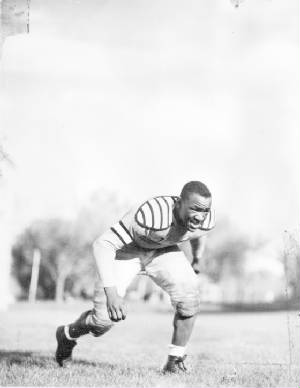
John Mosley as a Colorado
Aggie at Colorado A&M, now Colorado State.
Halfway through Mosley’s senior
season, the Aggies suffered a bitter 34-7 loss to CU in Fort Collins.
Mosley’s
last game for A&M was in Greeley. The Aggies took a 14-6 non-league win over Colorado State College of Education —
now the University of Northern Colorado — on Nov. 14, 1942, and finished 4-3.
Vice
president of his class when he was a junior and senior, Mosley had hoped to become the first African-American in Advanced
ROTC at A&M.
“I had the correct academics and was well-known on campus,
and I thought it was a shoo-in for me,” he said.
Then he took a physical at Fitzsimons
Army Hospital.
“Understand, I had been playing football for six years and
wrestling and taking physical exams every year,” he said. “I went back up to Fort Collins and was awaiting my
assignment for Advanced ROTC, and they said, ‘Sorry, you didn’t make it; you didn’t pass the physical.'”
Doctors told him he had a heart murmur. He was convinced that was ridiculous.
I asked Mosley if he was an angry young man at that point, given what he was going through in Fort Collins and in
football and wrestling.
“Very definitely, but I had had some very good white
friends and buddies up at CSU,” he said. “I certainly wasn’t angry at them. I was angry at the system.”
When the door was shut to Advanced ROTC, Mosley sought an alternative.
“They were starting up a program called civilian pilot training, and it was at most of the colleges around
the United States,” he said.
The civilian pilots ferried military aircraft to bases
around the country or even to bases overseas.
“So I decided, ‘This
is the way I am going to beat this game,'” Mosley said. “You had to get your own flight physical and pay for it.
I got my money together, went to the flight physician, and he examined and passed me.”
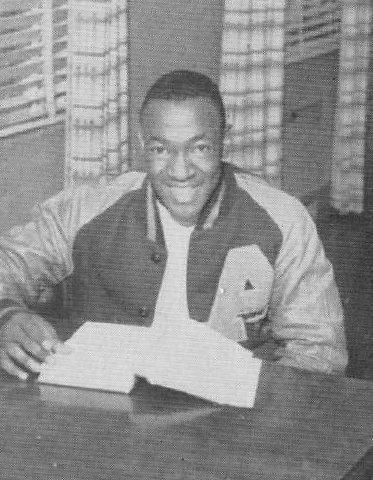
John Mosley was an honor
student at Colorado A&M
He started taking flying lessons in Fort Collins.
“When you signed up for civilian pilot training, you had to either sign up for the Army Air
Forces or the Navy,” he said. “At that time, the Navy wasn’t even thinking about having blacks fly their
airplanes. The only thing that was left was this experimental group, down in Tuskegee.”
The all-black 99th Pursuit Squadron, soon to be the 99th Fighter Squadron, had been formed in 1941. The first class
from Tuskegee’s Air Corps Advanced Flying School graduated in March 1942. By late that year, the 332nd Fighter
Group was considered the umbrella organization for the Tuskegee Airmen.
Before continuing
his quest to join the Airmen, Mosley received his diploma in spring 1943. Fort Collins businessman “Sparks” Alford
clumsily tried to congratulate him.
“Sparks was really the sponsor of the team,”
Mosley said. “He went on all our trips and he owned the Burlington, the bus run from Fort Collins to Denver. He did
give me a job of mopping up the bus station, which was just a little cubbyhole down by the train station.”
Mosley said he worked for Sparks for several years and considered him a friend. Yet he said Sparks’
congratulatory remark about graduation was this: “Hey, John, very good, if you ever get in jail, give me a buzz and
I’ll get you out.”
Mosley added: “To me, that was the most disappointing
thing, to suggest that I might be a candidate for jail … For him to think that the only thing I could do was get involved
in trouble some way left a very bad taste in my mouth.”
He was astounded
when he wasn’t drafted.
“My peers were given their degrees early so they
could go in,” Mosley said. “I got my degree, and my process was sitting and waiting. September came along, and
nothing. I thought for sure I would be going down to Tuskegee.”
He complained
to the draft board, and he was told that there had been a mix-up and his draft board believed he already had been called up.
Soon, he was called in to the Army. Instead of being sent to Tuskegee to fly, however, he was dispatched to a segregated
field artillery unit at Fort Sill.
“I started writing letters, along with my parents,
to congressmen and the White House,” Mosley said. “I said, ‘Look, I have actually been trained in flying,
and why haven’t I been sent down to Tuskegee?'”
He got his wish two months later.
“When I was going through,” he said, “they didn’t graduate any more pilots
than they needed … If they lost two people in the 99th, two people would graduate. They would eliminate you for anything
— shoes not shined or for any attitude you had that wasn’t appropriate. I often tell people I’m the best
pilot in the world, but there were pilots better than I was who got washed out for nothing because they didn’t realize
they had to demonstrate they could out-strategize their white instructors.
“I wanted
to get those silver wings. I knew I had to do everything in the world to scrap and to prove myself. Although we had black
instructors through primary training, they were all white instructors at basic and advanced. That’s where the washouts
were frequent.”
Then Mosley told me something that astounded me.
“I didn’t tell my flight instructors that I already knew how to fly,” he said.
Why not?
Mosley said the word was that instructors would feel
threatened by that and find a way to “wash out” that Airman.
Following pressure
from black-owned newspapers and from the White House, the first black airmen had served in combat, flying in the 99th Fighter
Squadron in North Africa and Europe, beginning in mid-1943.
Eventually, Mosley was one of the
first black airman trained to be a bomber pilot in the 477th Bombardment Group, activated in January 1944.
“They didn’t trust us with B-17s, with bombs,” Mosley said. “They thought
the first thing we’d do was head for 1600 Pennsylvania Avenue. They really had to sell Congress with ‘we think
we can trust those guys now,’ so we were permitted to fly B-25s.”
The
B-25 was a “medium,” twin engine bomber.
In April 1945, as the war was winding
down in Europe, the 477th was in training at Freeman Field in Indiana, which had two officers clubs, effectively one for blacks
(“trainees”) and one for whites (“instructors.”). Mosley was on a training mission to South Carolina
when black officers protested their exclusion from the whites-only club, and the incident and its multi-pronged aftermath
became known as the Freeman Field mutiny.
Sixty-one black officers were arrested
in the original April 5-6 protest, but charges against all but three were dropped. A week later, 101 were placed under arrest
in quarters when they refused to sign an order acknowledging the whites-only officers club was off limits to them. Those charges
eventually were dropped on April 23.
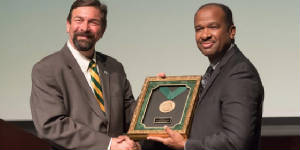
CSU President Tony Frank
presents the school’s Founders Day Medallion to John Mosley’s son, Eric, in 2017. Mosley was the eighth person
to be awarded the medallion. Eric Mosley was an Air Force and United Airlines pilot. (John Eisele/CSU Photo.)
“The commander of the airfield used to carry around a swagger stick and put it under his
arm,” Mosley said. “We used to mock him by picking up a stick and carrying that. He decided to court-martial everybody
involved. He had issued a statement that we were supposed to sign, that we understood we were not supposed to go into
the officers’ club. Of course, nobody signed it.”
They were sent
back to Godman Field in Kentucky.
“German prisoners also were housed there,
and they had the complete run of the base,” Mosley said. “They could use the PX. The airfield was somewhat
separate from the Fort Knox unit, but the Germans had assignments over there, picking up the trash and things like
that. It was most embarrassing to watch those German prisoners and then to look over there to the barracks that
housed the guys who were under arrest, and the German prisoners had the full run of the base, it seemed like. So you
knew what they thought of us. That was really disturbing.”
The three still
charged in the original protest were court-martialed that July. Two were acquitted. One was convicted of “jostling”
a white officer, fined $150 and dishonorably discharged. Members of the defense team included Thurgood Marshall, later a U.S.
Supreme Court justice from 1967-91, and Ted Berry, eventually the mayor of Cincinnati from 1972-75.
By then promoted from copilot to pilot, Mosley and others were ticketed to fly in Pacific combat had the war continued
into late 1945.
As a 1st Lieutenant reservist after the war, he was asked to write
a position paper about the possible integration of the armed services and was told it would it would reach President Truman’s
desk. He doubted that it did. But that report also is part of the reason why he always felt he had at least a small role in
Truman’s decision to issue Executive Order 9981.
“The integration of the armed
forces was really a prelude to all the kinds of civil rights activities that took place in this country,” Mosley said.
“That’s why I use the Tuskegee Airmen as being the basis for all of this developing and making America what it
should be.”
He obtained his Master’s degree in social work from the University
of Denver and worked for the YMCA until he was called back into the Air Force in 1950. During the Cold War years, Mosley spent
stints in the new U.S. Air Force flying supplies to West Germany and North Africa. During the Vietnam War, he was an operations
officer in Thailand as U.S. pilots flew bombing missions over North Vietnam.
After retiring
from the Air Force as a lieutenant colonel, he served as special assistant to the undersecretary in the Department of Health,
Education and Welfare in Washington before returning to Denver. He worked at the regional office for the Department of Health
and Human Services until he retired.
His wife, Edna, also was highly visible in the state.
She was a co-founder of the Women’s Bank, worked on the Colorado Civil Rights Commission and served on the Aurora City
Council from 1992-2004. Also a Manual High graduate, she had attended what now is UNC to start her college education, then
worked in the defense industry late in the war and eventually obtained her degree from Metropolitan State College in Denver.
She died in 2014, a year before her husband.
In 2004, CSU awarded both Edna and John
Mosley honorary doctorates.
Posthumously in 2017, John was the eighth person to
be awarded CSU’s Founders Day Medallion.
Earlier, he was inducted into the
Colorado Sports Hall of Fame in 2009. I was honored to introduce him at the banquet.












